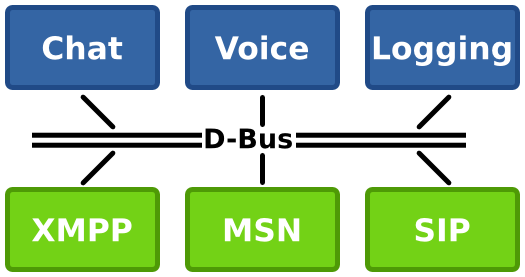Telepathy is a flexible, modular communications framework that enables
real-time communication via pluggable protocol backends. Telepathy
creates the idea of communication as a desktop service. It
uses
D-Bus
to separate components running in separate processes. Telepathy clients
use this D-Bus API (usually via a convenience library — e.g.
telepathy-glib) to share connections between multiple clients (e.g. an
instant messaging program, presence in email application, collaboration
in word processor).
Do One Thing and Do It Well
This is the Unix philosophy: Write programs that do one thing and do it
well. Write programs to work together.
Doug McIlroy
Telepathy components are modular, this means that developers can focus
on making each component being the best it can be.
Application developers can focus on user interaction whilst protocol
developers can focus on an individual protocol.
Backends for
many popular instant messaging protocols already exist including
XMPP/Jabber (telepathy-gabble), SIP (telepathy-sofiasip), MSN
(telepathy-butterfly) and IRC (telepathy-idle). The development of a
new protocol backend can be utilised immediately by all Telepathy consumers.
Telepathy backends can expose the different features of a communications
protocol, including presence (status), text chat (instant messaging),
voice and video conferencing, file transfer and
Tubes (contact-to-contact network sockets brokered by Telepathy); and do
this in a unified way via D-Bus interfaces.
Is Telepathy a Specification or an Implementation?
It's both.
There is one
specification
which defines the D-Bus API for how one Telepathy component talks to
another. Additionally there are many implementations of this
specification in the form of libraries that wrap the D-Bus API in a
model that might be more familiar to you; and components (e.g. the
Connection Managers) that allow you to do useful things with Telepathy.

